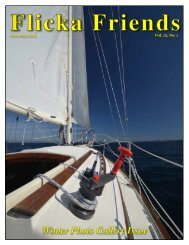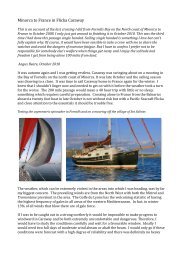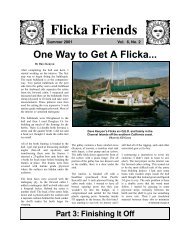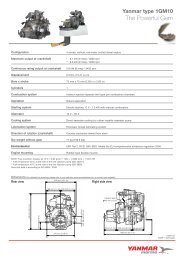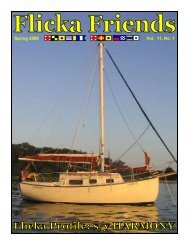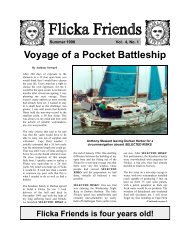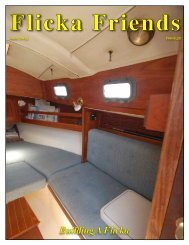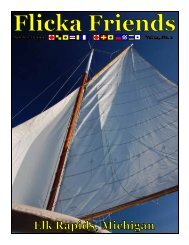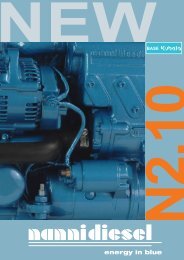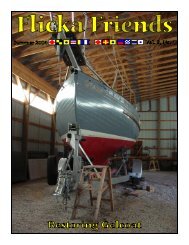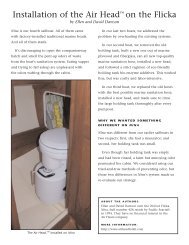Flicka Friends Fall 2013 - Flicka Home Page
Flicka Friends Fall 2013 - Flicka Home Page
Flicka Friends Fall 2013 - Flicka Home Page
You also want an ePaper? Increase the reach of your titles
YUMPU automatically turns print PDFs into web optimized ePapers that Google loves.
<strong>Flicka</strong> <strong>Friends</strong>September <strong>2013</strong> # 54 - Vol. 15, No. 6Building A <strong>Flicka</strong> - Part Two<strong>Flicka</strong> <strong>Friends</strong> 1
F L I C K A F R I E N D SC ONTENTSContents ......................................................... 2<strong>Flicka</strong> Photos ................................................. 2A Great Issue! ................................................ 3About <strong>Flicka</strong> <strong>Friends</strong> ..................................... 3<strong>Flicka</strong> Photos<strong>Flicka</strong> PassagesFlying and Buying My <strong>Flicka</strong> .......... 10Richard LawlessDestination Charlevoix...................... 16Randy RichardsonThe Last Thing You Check ................ 26Bill Hogan<strong>Flicka</strong> PortsFriday Harbor, WA ............................ 24Tom Davison<strong>Flicka</strong> ProjectsBuilding A <strong>Flicka</strong>, Part II.................. 6Bob CollierThe Sooty Water Blues ...................... 7Christopher QuintA New D.S.C. Radio ............................ 8Randy RichardsonGetting The Right Part ...................... 9Tom Davison<strong>Flicka</strong> GearTotes and Duffels ................................ 16Tom DavisonT HE N EXT I SSUE...The next issue of <strong>Flicka</strong> <strong>Friends</strong> is a photo galleryissue. Please send me photos of your <strong>Flicka</strong> and fromyour trips last summer for publication. Don’t forget toadd a caption along with where the photos was taken,your <strong>Flicka</strong>’s name, home port and hull number.Walter Lockhart’s <strong>Flicka</strong> s/y ISHA in Friday Harbor (# 40).This is his 27th summer of sailing in the Pacific Northwest.Photo: Tom Davison © <strong>2013</strong>Thanks!F RONT C OVERGetting ready to hook up the shore powerafter docking s/y RED RASCAL.Photo: Bob Collier © <strong>2013</strong>B ACK C OVERHeading out of Suttons Bay aboard s/y ZANZIBAR.Photo: Tom Davison © <strong>2013</strong>I SSUE 54, V ERSION 15.6.3WHISPER near the leeward mark of the America’s Cup in San Francisco Bay.Photo: Michael La Guardia © <strong>2013</strong>2<strong>Flicka</strong> <strong>Friends</strong>
F L I C K A F R I E N D SAnother Great Issue!A BOUTF LICKA F RIENDS<strong>Flicka</strong> <strong>Friends</strong> is a newsletter that iswritten specifically for the people whoown, crew aboard, or are interested in the<strong>Flicka</strong>, a twenty foot sailing vesseldesigned by Bruce P. Bingham.Based on the Newport Boats of BlockIsland Sound, this little ship has beenbuilt from various materials from the1970’s until 2002. This includes <strong>Flicka</strong>sconstructed from plans obtained directlyfrom Bruce’s California office. About 400sets of plans were sold. According toBruce Bingham, many <strong>Flicka</strong>s can befound in New Zealand, Australia, andSweden.A number of hulls were built by Nor’Starand some were completed by WesterlyMarine. The manufacturer of the bulk ofthe class is Pacific Seacraft who built 434hulls in California.<strong>Flicka</strong> <strong>Friends</strong> is published on aquarterly basis: with issues being postedto the internet in March, June, Septemberand December. Articles and photographsare welcome and encouraged.Heading south on Grand Traverse Bay at sunset.Photo: Tom Davison © <strong>2013</strong>By Tom Davisons/y BLUE SKIESWhile a bit late, this issue of <strong>Flicka</strong> <strong>Friends</strong>has a number of great articles. This issueinclude trips in Mexico, New Zealand,Michigan, and Washington.Bob Collier sent another installment aboutbuilding his <strong>Flicka</strong>, s/y RED RASCAL. This isthe second of twelve articles that describe theprocess of building a <strong>Flicka</strong> from Bruce P.Bingham’s plans.Richard Lawless has also sent in an articleabout buying his <strong>Flicka</strong> (s/y HEART ofGOLD) in New Zealand. This is the first partof a series of articles about sailing home toAustralia across the Tasman Sea, a solo 1,300mile passage. Richard will be sending in anumber of articles about his time in the watersof New Zealand and the crossing to Australia.Randy Richardson has a story about sailing his<strong>Flicka</strong>, s/y ZANZIBAR on Lake Michiganfrom Traverse City to Charlevoix.Bill Hogan has sent in an article from his tripaboard s/y NOMAD from southern Californiato Cabo San Lucas, and around to La Paz,Mexico in the Sea of Cortez.There are a few maintenance articles as well,including adding G.P.S. to a marine VHFradio, trying to get a correct GFI outlet, anexhaust modification, and totes for storage.There is a marina profile about Friday Harbor,Washington.My thanks to each of the <strong>Flicka</strong> captains thatsent in article for this issue! The next <strong>Flicka</strong><strong>Friends</strong> is a photo gallery issue. If you have animage and a caption about your <strong>Flicka</strong>, pleaseforward it to me ASAP!You can download the current issue aswell as the back issues of <strong>Flicka</strong> <strong>Friends</strong>from the <strong>Flicka</strong> <strong>Home</strong> <strong>Page</strong>:! www.flicka20.com<strong>Flicka</strong> <strong>Friends</strong> is always in need of articlesand photographs for publication. Pleaseconsider sending something to me for thenext issue of the newsletter.Editor:! Tom Davison! P.O. Box 462! Empire, MI 49630!Desktop:tom@syblueskies.comiPAD:syblueskies@me.com<strong>Flicka</strong> <strong>Friends</strong> 3
F L I C K A F R I E N D SLayout and FramesNailing the wood together allowed cutting identical frames for port and starboard side of my <strong>Flicka</strong>.Photo: Bob Collier © <strong>2013</strong>By Bob Colliers/y RED RASCALYour fanatical BuilderWhen we last left off, I had posed twoquestions: puzzles. To refresh our memories,they were:One: How to obtain the missing half-framepatterns since traditionally only the forwardhalf-frames of the starboard side were drawnand the aft half-frames of the port side. Thisprobably was to prevent too many confusinglines since each sister frame is a mirror imageof its opposite side.Two: How does one transfer the framepatterns to the lay-out board and still not cut,puncture, or damage the plans in any way.Well, I was confronted with these twoquestions as I began the building process.These are not academic questions. I checkedwith the books that I have and, with theexception of one source that recommendedcutting out a frame pattern, they seemed toagree that using an ice pick sort of tool (it issmaller than an ice pick and is referred to as a“lofting pick”) to puncture an outline of aChecking the sections to be sure of the right curvature and spacing.Photo: Bob Collier © <strong>2013</strong>4<strong>Flicka</strong> <strong>Friends</strong>
frame on the floor of the loft. This, however,would eventually shred the plans. But, boatbuilding companies have several copies ofthe plans. I have only one, so the loftingpick was out.OK, I decided to use CARBON PAPER. Myoffice had a few boxes that were no longerused due to the advent of the computer. Bylaying down several sheets of carbon paperI could transfer the frame pattern to thelay-out board.This answers question # (2). As to the first,I doubled the carbon paper and placedthem back-to-back on the lay-out board. So,now when I copied the plans while theywere affixed to the board, I not only got thepattern transferred to the lay-out board butalso on the back side of the plans.When I turned the plans over I had themirror image of the particular frame on theback. I just flipped the plans over and laydown more carbon paper, single sheets,face down, traced the carbon copy frameand, voila, question #(1) answered!Now that I had all of the frames drawn andcolor-coded, I began sawing the frames.Since the widest board I had was a 2x12”Douglas Fir, this meant that the frameswere cut in sections or pieces. Thesesections were placed on the lay-out board tomake sure they were of the correctcurvature.F L I C K A F R I E N D SThe port and starboard frames were cutsimultaneously to be sure that both sideswere equal. On which four 2x’s sectionswere cut at the same time and then put onthe lay-out board. They were temporarilynailed together to hold them in place duringthe cutting. The photo of sections on thelay-out board show the necessity of usingthe board to be sure one has the rightcurvature and spacing. The next photoillustrates the sections put together to forma complete frame.Half of the frames have been completed. For added strength,the gussets were added in front and back of the frame.Photo: Bob Collier © <strong>2013</strong>After the frames were all constructed, thetransom was next. This was 2 sheets of ¾”plywood epoxied together and cut toshape. This brings us to another problem.In spite of having moved a non-bearing wallback to gain a valuable 10” more (now thegarage was 20’ 10”. Wow! What was I goingto do with all that extra space?), I still couldnot build a 20’ boat in that cramped space.Well, the solution was to build a movable orrolling jig. This would allow me to turn theboat at an angle in the two-car garage.When I was done building for the day I’droll the jig/boat back against one wall andstill allow my wife to park her car in thegarage. The jig consisted of a rectangle 18’long and 6’ wide of 2”x 8” boards. At adiscount builders’ supply I bought six heavyduty casters, each able to support 500pounds, a total of 3,000 pounds.Your fanatical boat builder, Bob CollierThe building rig constructed. The frames were then attached to itby cross members of 2x4’s. The rolling jib was a great idea.Photo: Bob Collier © <strong>2013</strong><strong>Flicka</strong> <strong>Friends</strong> 5
F L I C K A F R I E N D SCarbon copying for the deadwood (that area of wood or fiberglass between thetransom and the keel. It provides support for the motor shaft, the shaft log). You alsosee the frames attached to the building jig.Photo: Bob Collier © <strong>2013</strong>Two layers of 3/4” plywood make up the transom.Photo: Bob Collier © <strong>2013</strong>The building jig was constructed and the frames were then attached to it by crossmembers of 2x4s. The rolling jig was a great idea, but I encountered a problem Ihadn’t thought about. The garage floor was not level. It was made to slope towardsthe entrance so that hosing off the floor would allow the water to flow out thedoor. So, that meant that each time I worked on the boat I had to re-plumb and levelthe jig! This added quite a bit of time to the building process. The deadwood is inplace (arrow) along with the keel and frames all attached to the jig. There is also aribband or temporary plank in place to stabilize the frames and keep them absolutelyvertical. As the planking proceeds these temporary planks are either removed ormoved to another position to hold this new area stable as added planks are applied.Photo: Bob Collier © <strong>2013</strong>Using jacks and a plumb bob for centering.Photo: Bob Collier © <strong>2013</strong>6<strong>Flicka</strong> <strong>Friends</strong>
F L I C K A F R I E N D SThe Sooty Water BluesThe hose in use with the enginePhoto: Christopher Quint © <strong>2013</strong>By Christopher Quints/y KATHLEEN FAY (# 297)I had been experiencing sootbuild-up from the exhaust onthe transom and the starboardside of the rudder. Thisoccurred after the first tank offuel had been half consumed.I knew that I was going to haveto check the condition of theinjector and injector fuelpump to make sure that I wasgetting the most out of myfuel. Until I had the time tocheck this out I wanted to seeif a simple addition couldlessen the black mess on thetransom.My exhaust thru-haulmeasured about 40 mm (19/16”) and at first I was lookingfor a piece of ridged bilge hose.None would fit well and then Isaw a roll of 2” vinyl pooldrain hose used on the exhaustside of a pump for drainingswimming pools to the streetor garden.I was attracted to this way ofproving the worth of my ideaas it only cost $1.59/foot! Ihad a 2” hose clamp already.This coupled up nicely andthen I got the idea to cut theoutboard end of the hose in aconvex crescent so the hosemouth would collapse like ajoker valve and preventseawater intake.Motoring home aboard s/y ZANZIBAR on Grand Traverse Bay.Photo: Christopher Quint © <strong>2013</strong>This 1 foot section of hose doesnot touch the water when theboat is at rest; it just hangs.Any wake from another boat isblocked from entering.While my boat is underway theexhaust easily belches out thehose without impedance.When I am sailing and she issquatting at the stern the hoselies flat on the water and thecrescent closes down. Best ofall, there is no more unsightlyexhaust soot anywhere, andmuch less smell of exhaustwhen a following wind scootsbehind us.Motoring home aboard s/y ZANZIBAR on Grand Traverse Bay.Photo: Christopher Quint © <strong>2013</strong>I have now had the engineparts rebuilt but I can’t thinkof a reason to take off the hoseexcept if I found one in navyblue!<strong>Flicka</strong> <strong>Friends</strong> 7
By Randy Richardsons/y ZANZIBAR (# 387)Recently, the decision was made to upgradeZANZIBAR’s antiquated VHF marine radiowith a new model that includes Digital SelectiveCalling (DSC). The main (really only) reasonthat I wanted DSC was its’ ability to transmit adistress call with the boat’s GPS positionembedded in the message. The West MarineVHF-580 radio was selected based largely onprice and local availability.Now that I had the radio, G.P.S. data wouldneed to be supplied. Usually this would be doneby connecting a chart plotter’s NMEA-0183output to the radios NMEA-0183 input. Sincemy <strong>Flicka</strong> doesn’t have a chart plotter, anothermethod would be needed to get GPSinformation. The solution was adding anexternal G.P.S. antenna to the VHF radio.The Globalsat BR-355 serial GPS receiver wasselected. Note that you must use the serialversion as the BU-353 USB receiver will NOTwork. The BR-355 required 5VDC so a little5VDC buck regulator was purchased to drop thepower from 12VDC to 5VDC.F L I C K A F R I E N D SA New D.S.C. RadioWith all the parts in hand, the radio wasmounted on the ceiling above the quarter berth.Next, the radio’s 12VDC input was run toZANZIBAR’s VHF circuit breaker on theelectrical panel and the existing VHF antennawas connected.The installation process was: Flip the breakeron and turn the radio on. It was Plug and Play. Iflipped the breaker back off and connected the12VDC input side of the DC12-DC5 converter tothe same breaker and flipped it back on. Ichecked the converters output with a meter andit read 5VDC. So far so good. I flipped thebreaker off again, cut the connector off the GPSreceiver and connected the bare wires to theDC-DC converter and radio using crimpterminals.I flipped the breaker back on, turned the radioon, and watched the display as it read “CheckingGPS.” After a few minutes the display changedto “GPS DATA OK.” I pushed the “ENT” buttonon the radio and sure enough, there it was:ZANZIBAR’s current latitude and longitudecoordinates. The last step in the project was toregister Boat/U.S. and input my MaritimeMobile Service Identity (M.M.S.I.) they issued.My new West Marine D.S.C. V.H.F. Marine radio installed above the quarterberth.Photo: Randy Richardson © <strong>2013</strong>A power converter and some basic rewiring made this project possible.Photo: Randy Richardson © <strong>2013</strong>The total cost of this project was about $180.00.Marine Radio * ............................ $120.00GPS Receiver **...........................$ 35.00DC-DC Converter ** ................... $ 5.00Crimp Terminals **.....................$ 5.00Shipping, taxes, etc. ..................... $ 15.00*West Marine ** AmazonThe “puck” G.P.S. antenna provides G.P.S. information to my new marine radio.Photo: Randy Richardson © <strong>2013</strong>8<strong>Flicka</strong> <strong>Friends</strong>
F L I C K A F R I E N D SGetting The Right PartThe AC main breaker and the non-GFI outlet aboard my <strong>Flicka</strong>. Time for new parts and upgrading.Photo: Tom Davison © <strong>2013</strong>By Tom Davisons/y BLUE SKIESWith three AC outlets on my sailboat, I wantedto make sure that there were no GFI issues.Since the non-GFI outlets were identified as aproblem in the survey, getting something newand proper was my plan. I checked the WestMarine website and found a video about theMarinco AC GFI Outlet with removable screwsto allow using ring connectors rather thanspades. Looked like a good way to go.Off to West Marine to purchase a Marinco ACGFI Outlet. Later I decided to convert all threeoutlet to GFI, so two more outlets werepurchased at a second West Marine on the wayto my <strong>Flicka</strong>. When I reached my sailboat, thepart wasn't right. It was a AC GFI outlet forhousehold use and NOT designed for marineuse. Looking into this part, I found:1). There is a small plastic "tooth" in the wayof the screws on my Marinco AC GFIOutlet. This prevents using a spade or aring connector unless removed.2). The electrical contact screws do NOTcome out. This prevents the use of aproper ring connector for marineapplications.3). Checking the packaging, there areinstructions for household wiring, i.e.wrapping the wire around the screw.4). I contacted West Marine to complaintabout the incorrect part. They forwardedmy complaint to Marinco who islooking into the problem.5). The Marinco technician said there is adifference from the other AC GFI Outlets:additional corrosion resistance andremoval screws.6). Leviton is the supplier for Marinco andMarinco has additional requirements.7). The Marinco GFI Outlets purchased atWest Marine are NOT the correct part forthe marine use.8). Looks like Leviton sent the wrong outlet,Marinco missed the mistake, and WestMarine did as well.9). My AC GFI outlets need to be replaced byeither West Marine or Marinco with thecorrect marine grade item.A bit of leg work over the winter should getthis resolved. So far, just a promise by WestMarine to refund my money.How much of a safety issue would the MarincoGFI AC outlets be if I had removed the smallplastic tooth and used a spade connector toinstall it into my sailboat? Probably less thanyou would think. Still, I wanted a marinegrade part for the AC outlets in my <strong>Flicka</strong>. Theones purchased cost at least double what theactual part that I received, and they will bereplaced with the correct part when available.The only AC appliance had been disconnectedon the last trip, so I decided to wait for thecorrect part, one that was designed for marineuse with the additional corrosion resistanceand the removal screws. This correct part willallow using ring connectors that was requiredfor a proper marine installation. Add sealedadhesive shrink connectors and theinstallation should be proper and safe.There is another method that could be usedand that would be the installation of a GFIsystem on the AC panel. Since the <strong>Flicka</strong> iswired to 1980 standards, there is no AC Panel,just a AC Main Breaker. I’ll be looking into thisarrangement as well.Hopefully, the correct part will be available forinstallation on my next trip aboard s/yBLUES SKIES in the Pacific Northwest.<strong>Flicka</strong> <strong>Friends</strong> 9
F L I C K A F R I E N D SFlying And Buying My <strong>Flicka</strong>My new <strong>Flicka</strong>, s/y HEART of GOLD in New Zealand.Photo: Richard Lawless © <strong>2013</strong>10By Richard “Riddy” Lawlesss/y HEART of GOLDI don’t know where the idea originally came from, but I’d always lovedtraveling, the ocean, planning the next adventure, and exploring newplaces. Sailing my own boat seemed to be ideal way to go, to be selfsufficient, having everything you needed with you, wherever you went,being responsible for yourself and the boat, but ultimately in the handsof mother nature. I read about sailing adventures way before I hadsailed myself. Books such as Dove by Robin Lee Graham, DesperateVoyage by John Caldwell, After 50,000 miles by Hal Roth and JesseMartin’s Lionheart all fueled the dream before I had could afford myown boat. I was always going to do it, it was just a matter of when.After finishing high school I brought a 14 foot Caper Cat catamaran,which I sailed around the Broadwater on the Gold Coast inQueensland, and the Gippsland Lakes in Victoria. The cat had enoughstorage in each of the hulls to fit plenty of camping gear and food. Itwas a fun, easy and forgiving boat to learn to sail on, but I was alwayskeeping an eye out for my next boat, something capable of goingoffshore and doing extended trips.Having lived in Chile for a year, backpacked through Asia and SouthAmerica for another year, I decided to knuckle down and study anEnvironmental Science at The University of Wollongong in NSW.Throughout the degree I worked a few casual jobs - research assistant,labourer, supermarket fruit & veg guy - always with the goal of buyinga yacht and doing a voyage somewhere. I constantly researched (andstill do) the different yachts out there, comparing what was affordable,what was available in Australia and what little yachts were toughenough to cross oceans. I considered Contessa 26’s, which were wellproven, but there weren’t many in Australia (Nick Jaffe, originally fromMelbourne in Vic, sailed a Contessa 26 singlehanded from the UK backto Aus in 2008/2009, his blog was a gold mine of information forsomeone planning a long voyage on a small boat, and on a budget).There were a few Nordic Folkboats around but many were wooden andneeded a lot of work, not to mention they looked pretty cramped. TopHat 25’s in Australia were another I was also considering, as well asRaven 26’s in NZ. I had first read about the <strong>Flicka</strong> 20 in the book‘Twenty small sailboats to take you anywhere’ by John Vigor but hadnever come across any the frequent boatpoint searches.One yacht searching procrastination session on trademe (NewZealand’s sort of eBay) brought me to a <strong>Flicka</strong> 20 for sale in NZ. She’djust returned from a singlehanded trip throughout NZ, Fiji, Tonga andback, and was sitting on a mooring in the Bay of Islands in NewZealand, pretty much ready to go again. I came back to this listing afew times, and the more I thought about it, the more I thought maybethis could just work. I had a 3-month summer university break comingup, I’d saved almost enough money and I had no commitments overthe coming summer.A bit more research into the <strong>Flicka</strong>’s showed they were well proventough little things. The one I was looking at, HEART of GOLD, wasbuilt by Nor' Star in 1975, and as far as I know, believed to be one of<strong>Flicka</strong> <strong>Friends</strong>
F L I C K A F R I E N D Sthe first Nor' Star hulls. The originalowner had her shipped out andimported to NZ, selling her when hemoved away. Researching the weatherin the Tasman at that time of year,Jimmy Cornells’ World CrusingRoutes suggested that, even though itwas cyclone season in the Coral Sea,Tasman crossings in the southernhemisphere summer were possiblegiven you had a good forecast.The pieces were falling into place, soafter a few phone calls I had returnflights to Auckland booked to check itout. I flew over in Sept 2011, took abus about 3hrs north of Auckland toOpua, in the Bay of Islands and stayedwith the boat’s owner, Richard Cross.In the morning we drove down to alittle boatyard tucked around thecorner from the main Opua marina.Heart of Gold was dried out alongsidethe dock at low tide. She looked like aproud, capable little thing sitting thereon its keel with her bluff bow, widebeam and solid looking bowsprit. Itook a heap of photos and checked outeverything on board.Even though I hadn’t been on manyyachts to compare, I was stillimpressed with how much room therewas in the cabin. The <strong>Flicka</strong>'s reallyare well laid out and comfortable for aboat only 6ft longer than mycatamaran.It had all the features you’d expect tofind on a bigger yacht: furling jib; fullybattened main with three reef points;a staysail on a boom; full heightlifelines; stainless steel bowsprit,bench tops and compression arch; two100 litre water tanks; 60m of chain onthe anchor; a proper LPG oven andstove; heater; fridge; toilet; plenty ofstorage; a reliable little Yanmar dieseland a cosy little bunk and bookshelf.We took her for a quick sail the nextday, then I flew back to Sydneycontent and satisfied that I'd foundwhat I'd been looking for. I ironed outsome of the finer details, organized asurvey to be completed, researchedimport taxes, Australian registration,moorings, etc. The survey didn't showany problems apart from a couple ofminor blisters below the waterline. Imade an offer which Richardaccepted, and she was all mine.My first sight of s/y HEART of GOLD, dried out along the dock.Photo: Richard Lawless © <strong>2013</strong>The boat did previously have a Navikwindvane on it when it sailed up toFiji. The previous owner Richard<strong>Flicka</strong> <strong>Friends</strong> 11
Cross couldn’t fault the Navik. It waseasily mounted (could be lashed on),lightweight and simple to use. Theonly down side being that they aren'tmade anymore and original partswere hard to come by. I found onefor sale on eBay in the US and had itshipped over to a friend's place inAuckland waiting for me. As soon asthe uni semester finished at the endof October that year, I flew back tothe Bay of Islands with a backpackand some books, and moved aboardfor the next 2 1/2 months.F L I C K A F R I E N D SLearning to sail in New ZealandHaving never slept onboard a yachtbefore, the first night aboard waspretty cool. I remember Rich Crossdescribed it to climbing back intothe womb, which if you don't thinkinto it too much, is a pretty gooddescription. I imagine it similar towhat a caterpillar might feel likegoing into a cocoon. Protected fromthe elements, tucked up in the Vberth and rocked to sleep, with thesound of water lapping the hull.The first few days aboard it rainedheavily and I was quite happy to stayon the mooring getting acquaintedwith all the little systems, diggingthrough cupboards discoveringspare alternators, anchors, shipsbells, old survey reports, chasingwiring and hoses under the V berth,pouring water into the bilge andseeing how fast it was pumped out,testing the LPG alarm andremembering what valves did what.The interior of s/y HEART of GOLD.Photo: Richard Lawless © <strong>2013</strong>Dad flew over for a couple of weeksto learn the ropes with me. Havingnever sailed before either (apartfrom on the 14 foott catamaran), hewas just as eager to learn as I was.Being a mechanic and having anatural ability to fix pretty muchanything, he had a good look overeverything including the littleYanmar. We changed the oil,replaced a few worn belts and aleaking water pump (apparentlypretty common on the Yanmar1GM's).We made a few modifications to thewindvane and mounted it on thestern. One thing we quicklydiscovered is how fast the days passwhen you're living on a mooring anddon't have a car. Nothing is a simpletask, going to the chandlery or thesupermarket become all day affairs.The bunk and books aboard my <strong>Flicka</strong>, s/y HEART of GOLD.Photo: Richard Lawless © <strong>2013</strong>12<strong>Flicka</strong> <strong>Friends</strong>
F L I C K A F R I E N D SAnchored in the warm New Zealand weather.Photo: Richard Lawless © <strong>2013</strong>At anchor in New Zealand, s/y HEART of GOLD is the smallest boat in the harbor.Photo: Richard Lawless © <strong>2013</strong><strong>Flicka</strong> <strong>Friends</strong> 13
F L I C K A F R I E N D SMy father working on the Yanmar inboard diesel engine of s/y HEART of GOLD.Photo: Richard Lawless © <strong>2013</strong>HEART of GOLD anchored in the Bay of Islands, New Zealand.Photo: Richard Lawless © <strong>2013</strong>14<strong>Flicka</strong> <strong>Friends</strong>
F L I C K A F R I E N D SBefore we left the safety of the mooringfor our first sail we raised and loweredthe main, unfurled and furled thegenoa, checked the engine went in andout of gear smoothly and chose a paththrough the other moored boats toopen water.One of my first concerns was hittinganother boat whilst coming and goingfrom the mooring. I learnt that thesethoughts (concerns, worries, fears....)remain with you all the time whenyou’re sailing. I think they're a goodthing to have, like an awareness of whatcould go wrong and how quickly itcould happen. It keeps you on your toesand makes you think three steps ahead.As my experience grew, theconsequences got progressively moreserious. Will the anchor dragovernight? Will the motor start first goif I don't make this tack? Is that wherethe unmarked reef was? Will a tankerrun me down overnight? Will I be ableto go to windward in 30 knots off a leeshore? What if my windvane breaks inthe middle of the Tasman? It's a part ofsailing that I like, those little thoughtsin the back of your mind. They're oftenmissing in daily life on land and makeyou feel alive with the sense ofapprehension, responsibility, relief andachievement they offer in return forhaving them.We took a few short day trips up anddown the channel from Opua to Paihiaand Russel before venturing furtheraround the point into the Bay ofIslands. One afternoon early on we puta reef in for the first time. It wasprobably only blowing about 25 knotsbut we just went back and forth acrossthe channel, dad at the helm while Iwas working out the reefing lines andsail ties.I pulled the main in to its third reef Iremember we were pretty pleased withour efforts. It was surprising how muchdifference reducing the sail area made.The heel angle reduced, the weight onthe tiller lightened, boat speed sloweddown and there wasn't as much spray.These were the sort of little steps wetook that helped my confidence build. Ihad read about the theory andtechnique in books but actually doing iton my own boat was a different thing,solidifying all the reading in experienceand memories.Putting in the first reef ever on s/y HEART of GOLD.Photo: Richard Lawless © <strong>2013</strong>Editor: Addition stories about HEART ofGOLD will appear in futureissues of <strong>Flicka</strong> <strong>Friends</strong>.<strong>Flicka</strong> <strong>Friends</strong> 15
F L I C K A F R I E N D SBy Tom Davisons/y BLUE SKIESMy <strong>Flicka</strong> is far from where I live and gettingthings to and from the sailboat can be achallenge at times. Besides organizing themovement of items for flying, there is a needto manage things onboard as well.Totes and DuffelsA four roller suitcase has been purchased toget everything through the airports. Thissuitcase moves freely without the need to dragit along. While this is great in airports, asuitcase really doesn’t work on a <strong>Flicka</strong>.Luckily, I have storage on the island and thebulky suitcase can be changed to somethingelse.One of the best things for me under the treelast Christmas proved to be one of the leastexpensive. My wife ordered a L.L. Bean Totewith my boat name embroidered on it. It wasan instant hit with me and I couldn’t wait to beback aboard my <strong>Flicka</strong> in the PacificNorthwest to try it out. My Christmas tote wasa large model with the regular straps and azippered enclosure.These totes come in a variety of sizes, somewith or without a zipped enclosures andregular or long handles. The tote proved veryhelpful in getting things to and from the<strong>Flicka</strong>. Since I remove everything betweentrips, gathering everything was difficult.The first trip to storage required several trips with a cart. Too much loose stuff!Photo: Tom Davison © <strong>2013</strong>On the last trip, I needed more totes, butordering them takes time. Another option wasneeded. The solution was actually a gift from amarina. While at the Cap Sante Marina inAnacortes, Washington, they were making aserious effort to fill the twenty-five percent ofthe marina’s boat slips that were empty. Theyhad key floats, brochures, and some otherpromotional items. One item they gave me wasa small tote bag with their marina’s name onit. This proved to be the inspiration fororganizing my <strong>Flicka</strong>.Since this grocery bag style tote bag easily fiton the shelve above the v-berth, I wanted tofind a few more. The remedy was no fartherthan the grocery store on Lopez Island. I droveover to see what they offered and purchasedsix of them. The cost was low, a couple ofdollars for each one.Back aboard my <strong>Flicka</strong>, I found that they fitnicely and allowed gathering all themiscellaneous items quickly and easily. All thelittle items quickly disappeared into them.When it came time to clear out the <strong>Flicka</strong> atthe end of the trip, it was accomplished inthree cart loads. Considering that the cushionsand sails were taken as well, this isn’t too bad.Loading and unloading is even easier now thatI’m adjusting to tide tables and waiting for theReusable grocery bags solved the moving problems for s/y BLUE SKIES.Photo: Tom Davison © <strong>2013</strong>16<strong>Flicka</strong> <strong>Friends</strong>
F L I C K A F R I E N D Shigh tide when I can to eliminate the steeppitch of the gangway to the parking lot.The latest addition for traveling is a largeNorth Bag duffle bag. Primarily, this bag willbe used to hold all my stuff for a trip on thewater. Clothing, life jacket, rain gear, sunscreen, a fleece jacket, Tilley hat, and whateverelse might be needed. This keeps everything ina single location and you don’t have to beconcerned that you left something behindeither at home or on the boat. It also fits insidemy new roller suitcase with some spare room.A duffel and two totes: Plenty of room for everything!Photo: Tom Davison © <strong>2013</strong>Talking with others using the North Faceduffel bag while at airports, I’ve heard somegreat things. These bags are bomb-proof. Theyare durable and they last. One person I talkedto had what appeared to be a brand new bag.In fact, he had been using the bag for anumber of years on many flights.The North Face duffel has regular carryingstraps and a shoulder harness system so youcan carry the bag like a backpack. The strapsare removable in case you check the bag at theairport. The only down side is the initial cost,but the lifespan of this great bag should negatethis one drawback. You get what you pay for!One other advantage of the L.L. Bean totes ishaving one in your suitcase. I did on the lasttrip to the Pacific Northwest and found thatthe single bag exceeded the standard weightlimits. The bottom line is that checking thesuitcase would mean a $200 charge. Havingthe tote with me allowed splitting the itemsinto two bags and checking them. The resultwas a charge of $25.00 for the first bag and$35.00 for the second, a savings of $140.00.The quarterberth is perfect place for the duffel. Shoulder straps make carrying easy.Photo: Tom Davison © <strong>2013</strong>Another path for those with sewing machineswould be the creation of custom totes thatactual fit the space on the shelves and maybesome of the lockers in the <strong>Flicka</strong> too. Theywould maximize the use of every inch of spaceaboard and eliminate the cluttered look thatmany cruising sailboats take onboard. Thingslike tool bags and tool rolls come to mind. Theheavy duck fabric could be replaced withlighter Sunbrella fabric, something that wouldshed water better.My birthday brought another one of thesetotes, identical to the first one except that ithad the longer handles which makes the usingthe bag much easier. The shorter handles don’tstay on your shoulder while the longer oneswill. Perfect for hauling groceries or laundry.The L.L. Bean Totes bags in the cockpit of s/y ZANZIBAR.Photo: Tom Davison © <strong>2013</strong>Looking forward, there will be more “real”totes ordered from L.L. Bean. Until then, thefabric reusable grocery bags will be usedaboard s/y BLUE SKIES. Replacing adamaged or worn out grocery bag will be easy.Adding a tote from each marina that I visit is aanother way to add a tote bag.<strong>Flicka</strong> <strong>Friends</strong> 17
F L I C K A F R I E N D SDestination: CharlevoixBy Randy Richardsons/y ZANZIBARThe original plan was to sail solo from TraverseCity to Beaver Island by way of Northport andCharlevoix. However, Charlevoix was so nice Idecided to spend an extra day there and make aday trip to Beaver on the ferry.The trip started from ZANZIBAR’s home port ofElmwood Marina in Traverse City, Michigan. Thefirst leg up Grand Traverse bay to Northport wasabout twenty-five miles. The wind started outlight but built as the day progressed. SoonZANZIBAR was galloping up the bay on a broadreach at six mph.ZANZIBAR at the dock in the City Marina of Charlevoix, MI.Photo: Randy Richardson © <strong>2013</strong>By the time we turned into Northport bay thewind was really blowing and the clouds werelooking pretty ominous. It was nice to get settledin a slip and put on a pot of soup. The next daybroke with small craft warnings so I stayed put inNorthport Marina for another day.The weather was severe only five miles south of ZANZIBAR and Northport. MI.Photo: Randy Richardson © <strong>2013</strong>18<strong>Flicka</strong> <strong>Friends</strong>
F L I C K A F R I E N D SThe following day, the small craft warnings werelifted. The Lake Michigan buoy was reportingwinds out of the Northwest at twenty to twentyfiveknots with waves from two to three feet. Timeto go, after getting a sweet roll and coffee atBarb's Bakery of course.The leg from Northport to Charlevoix was abouttwenty miles. Before clearing Northport Point, Iput a reef in the main and rolled in half thegenoa. It was a little blustery out on LakeMichigan, but ZANZIBAR was in her elementand heading for Charlevoix on a course of 060True. The next turn was a the Green can buoy “1”located off of Fisherman Island.Along the way, ZANZIBAR and I would cross asimple boundary at the mouth of Grand TraverseBay. It would be the first time in the open watersof Lake Michigan for both of us.Plotting the course for the next day: Northport to Charlevoix.Photo: Randy Richardson © <strong>2013</strong>The Saint Mary’s cement plant on South Pointnear Charlevoix makes a great landmark whichcan be seen from miles away. At Buoy “Red 2” offSouth Point, we turned to 113 True and headedfor the Pine River that connects Lake Michigan toRound Lake and then into Lake Charlevoix.The Memorial Bridge is a double leaf basculebridge over the Pine River and it opens on thehour and 1/2 hour if needed to let sailboats, largeboats or ships through. The Charlevoix CityMarina is on the west side of Round Lake so youneed to deal with the bridge if you're going to themarina.Fine dining aboard Hotel ZANZIBAR.Photo: Randy Richardson © <strong>2013</strong>This was my first time sailing into Charlevoixand, being by myself, I was a little worried aboutthe bridge. Both sides of the river have high steelseawalls that will not accommodate tying a smallsailboat to. The Pine River Channel is onehundred and fifty feet at the mouth and the widthdecreases to one hundred ten feet at theMemorial Bridge.The large Emerald Isle ferryboat that runsbetween Charlevoix and Beaver Island uses theriver and there is also quite a bit of recreationalboat traffic in the summer. I timed my entranceto coincide with the bridge openings and to avoidthe Ferry schedule.I got to the bridge a few minutes early. The windwas blowing me toward the bridge so I couldn'tjust sit and wait for it to open. The only thing Icould think to do was to drive around in circlestimed to fit in between the power boats going inand out of the river. This would sure have been abad time for the diesel to go on strike.Fortunately, the little Yanmar chugged away untilthe bridge opened and we were back on our way.Morning stop before heading into Lake Michigan.Photo: Randy Richardson © <strong>2013</strong>After clearing the bridge and coming into RoundLake, a turn to starboard took us to the marina.What a beautiful place and a great marina staff.Rebuilt in 2007, this marina blends well into thetown. The stonework around the marina and park<strong>Flicka</strong> <strong>Friends</strong> 19
F L I C K A F R I E N D SThe cement plant near Charlevoix, Michigan.Photo: Randy Richardson © <strong>2013</strong>Turning toward the Pine River at the bell buoy.Photo: Randy Richardson © <strong>2013</strong>Heading under the bridge and into Round Lake.Photo: Randy Richardson © <strong>2013</strong>The bridge over the Pine River in Charlevoix, Michigan.Photo: Randy Richardson © <strong>2013</strong>The Charlevoix Marina was rebuilt in the last ten years.Photo: Randy Richardson © <strong>2013</strong>Besides new floating docks, there is a large green space.Photo: Randy Richardson © <strong>2013</strong>20<strong>Flicka</strong> <strong>Friends</strong>
F L I C K A F R I E N D SA day trip to Beaver Island aboard the Emerald Isle.Photo: Randy Richardson © <strong>2013</strong>Beaver Island is located thirty-two miles from Charlevoix.Photo: Randy Richardson © <strong>2013</strong>The St. James Yacht Club on Beaver Island.Photo: Randy Richardson © <strong>2013</strong>Historical Museum in St. James, Michigan.Photo: Randy Richardson © <strong>2013</strong>Sunset over the Pine River and Lake Michigan in the distance.Photo: Randy Richardson © <strong>2013</strong>Lights around the Charlevoix Marina from the boat slip.Photo: Randy Richardson © <strong>2013</strong><strong>Flicka</strong> <strong>Friends</strong> 21
F L I C K A F R I E N D SAn early morning departure from Charlevoix aboard s/y ZANZIBAR and the next stop is Elmwood Marina - 40+ miles away.Photo: Randy Richardson © <strong>2013</strong>Another sailboat followed me out of the Pine River into Lake Michigan.Photo: Randy Richardson © <strong>2013</strong>22<strong>Flicka</strong> <strong>Friends</strong>
F L I C K A F R I E N D Sflows in wavy patterns and quaint street lampsilluminate the pathways. The marina’s rockwork was designed to emulate the patterns onthe eight so-called mushroom houses inCharlevoix that were designed by Earl Young(1889-1975).The marina is located next to a large open areapark which has a band shell where soft jazzwas being played. Above the marina, littleshops and small restaurants line Bridge Street.The Weathervane and Edgewater restaurantsare just a short walk back to the river and areboth great if a more upscale dinner is desired.Olson's supermarket is within walkingdistance to the south for resupplying the shipsstores.I had planned on leaving the followingmorning to sail to Beaver Island but was soimpressed with Charlevoix that I decided if Icould keep my slip for another night I wouldstay here and make a day trip to Beaver on theferry instead.It all worked out. The Emerald Isle ferryboatcovers thirty-two miles in two hours. The ferrytrip and time spent on the island was a lot offun.With no wind, motoring home was the only option.Photo: Randy Richardson © <strong>2013</strong>Beaver Island is a thirteen by six mile islandwith a year-round population of 687 people.Services are varied and include most thing youwould need to visit or even winter over. Theisland traces it’s roots to Ireland and youmight see the Irish courtesy flag flying on astarboard spreader.After spending another enjoyable night inCharlevoix it was time to head home. Dealingwith the bridge at six in the morning withcalm winds was a no brainer. Just sit and waitfor it to open.Being “inside” of the bridge is almost never aproblem. However, a week after leaving, thebridge “stuck” in the down position for sevenhours while an electrical problem wasdiagnosed and repaired.The windy conditions of the preceding dayswhich made for such good sailing was overand the trip home was made motoring. Theautopilot was put to good use on the way backinto Grand Traverse Bay.By afternoon it was dead calm and gettingpretty hot under the August sun. An umbrellawas rigged to the boom to provide a littlemuch needed shade for the remainder of thetrip.Hiding from the sun on the calm and hot trip back south in Grand Traverse Bay.Photo: Randy Richardson © <strong>2013</strong>After forty-five miles of motoring, s/yZANZIBAR and I were back home. This hadbeen a great trip. It was a lot of fun sailing andstaying aboard my <strong>Flicka</strong>.<strong>Flicka</strong> <strong>Friends</strong> 23
F L I C K A F R I E N D SFriday HarborSan Juan Island, Washington48º 32’ 12” North , -123º 00’ 88” WestWith space for five hundred boats, Friday Harbor is the largest marina in the San Juan Islands.Photo: Tom Davison © <strong>2013</strong>By Tom Davisons/y BLUE SKIESJust about every type of watercraft can befound in and around the Port of FridayHarbor. This includes small paddling androwing vessels, cruising power and sailboats,large yachts, commercial fishing boats, andWashington State ferryboats. Add scheduledfloat plane service along with regular ferryarrivals and you have a busy mix. Arrive on aweekend or holiday and this harbor is mostlikely the busiest in the San Juan IslandArchipelago. For some, this may be busierthan they care for, but Friday Harbor is a goodplace the stop on the to other areas.With twenty restaurants, finding a place to eatisn’t a problem in Friday Harbor. A widevariety of foods are available. Many of thebusinesses are located just blocks from themarina.There are a variety of businesses that cater tothe 2,162 residents of Friday Harbor and6,894 residents of San Juan Island. Theyinclude bookstores, bakeries, automotivesupplies, hardware, a farmer’s market, andmany marine related businesses can be foundas well. They run the spectrum from canvas foryour boat, to repairs, parts, hauling,mechanical & electrical services, and a smallWest Marine store.Tourist related businesses abound, with whalewatching, boat tours, sailing tours, kayaktours, gift shops, specialty shops, and theWhale Museum.Friday Harbor is a busy stop for theWashington State Ferry System with trips tothe other islands, the mainland in Anacortes,and west to Sidney, Canada. There is U.S.Customs as well for clearing into the states.Friday Harbor is a good place to stop torecharge your batteries, fill the fuel tank andget ready for exploring the San Juan Islands.Friday Harbor is close enough to most placeswithin the San Juan Islands and only hoursfrom Canada and the Gulf Islands.24<strong>Flicka</strong> <strong>Friends</strong>
F L I C K A F R I E N D SService / InformationLocationWashingtonLatitude 48° 07’ 48”Longitude 85° 36’ 38”Boat RampNo / NearbyBoat Slips / Transients 500+ / 100+Boat Draft 5-6’ to 50-60’Boat Slip Length 20 to 300’View of the Port of Friday Harbor from the marina office.Photo: Tom Davison © <strong>2013</strong>The gas dock at the Port of Friday Harbor.Photo: Tom Davison © <strong>2013</strong>Boat StorageBrokerageCable TVCarts for Marina UseConcession / VendingCustomsDieselElectrical 30/50/100 AmpFish Cleaning StationGarbage / Waste / RecyclingGasolineIce / GroceriesInternet / Wi-FiLaundryLaunch FeeLodgingMooring / Dinghy DockPost OfficePump-OutRepairsRestroomsNoYesFree WifiYesOne BlockYesYesYes / Yes / YesYesYes / Yes / YesYesYesYesYesN.A.NearbyYes0.5 mileFixed & MobileYesYesRestaurants Close by, nearly 50Safe HarborSecurity / Gated AccessShip’s StoreShowersN.A.Yes / NoYESYesTelephone (360) 378-2688TowingTrailer StorageTravel-LiftYesYesTwo Ton CraneLooking across Front Street and up Spring Street in Friday Harbor.Photo: Tom Davison © <strong>2013</strong>Water HookupYesYear Built 1950 / 1972<strong>Flicka</strong> <strong>Friends</strong> 25
F L I C K A F R I E N D SThe Last Thing You CheckRowing out to s/y NOMAD, anchored in the calm La Paz Channel after weathering the storm.Photo: Bill Hogan © <strong>2013</strong>By Bill Hogans/y NOMAD“The forecast looks good for hitting the Cerralvo Channel, the trip toIspiritu Santo’s Playa Bonanza is a short 40 mile hop, and we’ll be ableto judge when the current turns in the San Lorenzo channel mucheasier than from here at Los Muertos.”So began the most exciting, difficult day of our trip. Storm stories are astaple of cruising narratives, yet storms and heavy weather made uponly a tiny fraction of the time we spent voyaging. We neverencountered true heavy weather, and we never had to adopt any stormtactics - defined as survival tactics such as heaving to, deploying adrogue, or abandoning upwind progress and running. We were alwaysable to make way towards our destination, even when it was blowingover thirty knots, even when our destination lay upwind. We neverneeded the storm jib or trysail.Isla Cerralvo has a notorious channel that lies approximately 100 milesNorthwest from the tip of the Baja Peninsula. The waves here are someof the largest in the Sea of Cortez. The wind blows hard andconsistently. Kite surfers come from all over the world to ride at LaVentana beach adjacent to the channel.We departed the absolutely beautiful Bahia de Los Muertos at 11:00a.m., hoping to ride a 2.5 knot tidal current before it reversed twelvehours later. With following winds a strong current is no problem, but ifthe wind turns against the current, look out! Small wind waves quicklysteepen and start breaking. Our weather prediction service, thegenerally reliable internet based Predict Wind showed a beam wind often to fifteen knots, with the possibility of twenty knots in the evening.“Hmmmm - Hey Saba, I think we should continue to Playa Bonanzatoday, and ride this breeze for all its worth. Playa Bonanza is an openroadstead anchorage supposedly without hazards.”“OK - sounds good.”At around 3:00 p.m., a Mexican Navy gunboat appeared on thehorizon, parked directly in the middle of the Cerralvo channel.“Look - There’s the Navy, ha-ha-ha - Maybe they will board us like theU.S. Coast Guard did in Long Beach, Jack boots and all!”We were under spinnaker, just like we were in Long Beach, and I hatedthe thought of having to stop for some silly “safety inspection” orwhatever...26<strong>Flicka</strong> <strong>Friends</strong>
F L I C K A F R I E N D SWaves were breaking every three seconds against the bow and althoughthey were not large - four or five feet maximum, they were steeper andmore vicious than any I’d ever seen. Their small size and short period isthe sweet spot sea state were NOMAD is the least happy.Sour spot?In big swells a <strong>Flicka</strong> rides like a duck - up and over the waves, but inthe small stuff the ride is bumpier- she heels over 25 or 30 degrees,water comes over the lee rail, and you bounce along like a ping pongball.Since conditions were still building I made the decision to remove theflexible solar panels we deploy atop the Bimini in fair weather, andhanded them down the companionway to Saba who stowed thembelow.We then folded the Bimini and lashed it to the cabin-top to reducewindage aft and the resultant “weather helm” or steering imbalance itcreates in strong conditions.NOMAD was charging along well at this point, but I’d made an errorin sheeting our heavy weather jib by not re-leading it’s sheets outside ofthe shrouds. This meant that the sail had a lot of twist in it, which whilegood for spilling air in the gusts, gave her “lee helm” in the lulls -meaning she was not pointing as close to the wind as possible, and thisis also hard on the sailcloth - allowing the leech (trailing edge) of thesail to flog.Once the boat was settled down and making her way towards what ourguide books promised would be a safe haven, I asked Saba to pass meup some water to rid myself of the dry metallic taste filling my mouthfrom the adrenaline rush. Just as I asked her for a drink, the biggestwave the storm came over the front of the boat, and hit me in squarethe face.Saba enjoys the view as s/y NOMAD loops along downwindunder maximum possible sail: an asymmetrical spinnaker, a140% genoa poled out and full main (sheeted amidships todamped trolling). Over 600 square feet of sail on a 20 footrequires caution and constant vigilance to windward for windshifts or changes. Photo: Bill Hogan © <strong>2013</strong>We trudged along for the next couple of hours, and the ship didn’tmove. About a mile from the ship, just as we cleared the northern tip ofIsla Cerralvo, I noticed some VERY dark water to the Northwest. “Let'sdrop the kite and putting up the 140 Genny - it will be dark soon, and Idon’t like the looks of that water to windward.”Note:Thirty-six knots as recorded by our weather stationon the evening of April 10th in the Cerralvo Channel.After hoisting the big genoa, the water continued to darken, and it wasclearly advancing towards us, so I took out the binoculars to get abetter look. What I saw looked terrifying: boiling black water toppedwith whitecaps. I decided we'd better reef down the main, strike theGenoa, and put up the heavy weather jib. Just as I completed thosetasks we were hit with a wall of wind and water, the likes of which I'dnever seen before.The Navy gunboat turned tail, and began running before the buildingwind. A one hundred foot long steel warship, high-tailing it gave uspause.“Looks like we're in for it baby – hang on!”"Hey Saba - can you pass me up Water…..WHAM!...“.....HEY! I meant FRESH water!!!!!”Saba was laughing hysterically, and despite the storm, I had to laughwith her at the timing of that wave strike."Yea, OK, that WAS pretty funny, I’ve gotta admit.....”The boat was charging along happily under autopilot, when suddenly,the autopilot lost power, and I had to take over. Luckily, it was just acircuit breaker that had overloaded, and Saba was able to quickly resetit. Then, the worst of the wind and waves struck, with NOMADburying her lee coaming, along with the winch under water. Greenwater sloshed over the coaming into the cockpit, and we were knockeddown past forty-five degrees – not so much by the wind, but by a seriesof waves. Still, she was making well over five knots, even with thepounding she was taking.Then, a few minutes later:ALL POWER WENT DOWN.To make matters worse, darkness had fallen, making the loss of powereven more critical. Without any power we were flying blind - No GPS,no depth sounder, no running lights, no cabin lights, or even a light forthe compass to steer by. I attempted heaving to, but with the maindouble reefed she refused to keep her head up in the thirty-five knotbreeze.This is why we have back-up lighting, and why I repeatedly practicedtraditional navigation and compass steering leading up to our voyage. Ihad Saba dig out the backup navigation lights, and I quickly lashedthem to the boat. Saba then booted up the I-pad, which had Navionicsloaded. She propped it up on the chart table where It was out of theweather, but I could see it from the helm. I figured out which heading<strong>Flicka</strong> <strong>Friends</strong> 27
was best, and commenced hand steeringtowards Playa Bonanza, a supposedlysheltered anchorage on the east side of IslaIspiritu Santo twenty-five nautical miles away.Twenty-five nautical miles. Crap. That'salmost thirty normal miles. I had Saba passme a headlamp, and she lit our oil lamps forcabin lighting. We'd already been out for overeight hours, and had another five to go underdifficult conditions.At the end of the passage lay an unfamiliarlandfall at night, with dicey one hundred andfifty year old charts (seriously) without a depthsounder. We didn't have so much as a moonfor illumination.F L I C K A F R I E N D SAt least the shore we were clawing towardswas a weather shore. Aborting our approachwould be easy and safe if it came to that,allowing us to reach or run off away fromdanger. We were prepared to run off acrossthe entire Sea of Cortez if needed, but thingswere certainly not desperate, justuncomfortable.To anchor, we’d need our chart-plotter’s depthsounder to determine depth and the amount ofchain required for good holding.Thirty-six knots as recorded by our weather station on the evening ofApril 10th in the Cerralvo Channel.Photo: Bill Hogan © <strong>2013</strong>I lashed the helm, and went below to see whatI could do…..As wind and waves lashed our little boat, Itried to calmly assess the situation and ouroptions:Concerns:1. We had no autopilot. This meant I had tohand steer, when I really would havepreferred to keep watch from down below,where it was warm and dry.2. We’d been dressed for the warmafternoon, but now it was dark, and I waswet. Although the air and water weren’tvery cold, the desert air was very dry,leading to evaporative cooling andpotential hypothermia.Our route on the evening of April 10th in the Cerralvo Channel.Photo: Bill Hogan © <strong>2013</strong>3. We had no chart-plotter or depth sounderfor navigation4. We had no fixed VHF radio to call for help5. We had no navigation lights and wereinvisible to other shipping6. We did not have a powerful engine, just asmall electric outboard.On the plus side:1. Saba and I were proficient at sailingNOMAD without electrical gear. We hadpracticed sailing compass courses anddead reckoning.The path of the winds on April 10th in the Cerralvo Channel.Photo: Bill Hogan © <strong>2013</strong>28<strong>Flicka</strong> <strong>Friends</strong>
F L I C K A F R I E N D S2. We had experienced strong winds and bigwaves traveling down the Pacific, and hada routine for clearing the decks andsecuring things below when the sea kickedup, and we had immediately reducedsail, reefed down the main, cleared thedecks, and battened down the hatches asthe winds approached.3. I had extensive experience in handsteering compass courses.4. We had two fully charged hand-held VHFradios, three EPIRB rescue beacons, and asatellite phone programed withemergency numbers.5. We had a fully charged I-pad withdetailed charts of the area we were in.6. We had adequate food and water for aextended stay at sea if needed.NOMAD approaches Cabo San Lazaro off Baja’s Pacific Coast.Photo: Bill Hogan © <strong>2013</strong>7. We were closing on a weather shore asopposed to being pinned against a leeshore, giving us the option of aborting ourapproach and running right back fromwhere we came from.8. I’d purchased standalone, portablebattery powered navigation lights -although we were the only boat out there.9. We were well practiced at anchoringunder sail, even at night, even inunfamiliar anchorages.The first priority was to maintain control ofthe boat. Well, the boat took care of that all byherself, even with the helm lashed.Next - thermal management. I lashed the helmand donned my full foul-weather gear - stayingwarm and dry was essential to maintainingstamina and judgment. We needed depthinformation if we were going to anchor thatnight, so I lashed the helm again and crawledbelow and attempted to troubleshoot theelectrical problem with the boat knocked down35 degrees, hard on the wind.Rather than attempt to track down theelectrical fault, I grabbed the multi-meter andquickly determined that our 400 ah housebattery bank was fully charged, so I grabbedsome wire cutters, strippers, and a couple oftest leads, cut the chartplotter wires away fromthe main electrical bus, and jumped themdirectly to the main batteries...SUCCESS!Caleta Lobos, the water really is that color!Photo: Bill Hogan © <strong>2013</strong>We now had speed, depth, and track info inthe cockpit. I keyed in the coordinates awaypoint off of Playa Bonanza, from ourcruising guide, and headed off into the pitchblack night towards it. Twenty minutes withthe helm lashed and we were perfectly on<strong>Flicka</strong> <strong>Friends</strong> 29
course. Perfectly. Better than I'd done activelysteering. <strong>Flicka</strong>'s are that good. We reachedPlaya Bonanza about four hours later.The bilge alarm went off just once, and twostrokes of the manual pump quickly cleared it.Its true what they say: in heavy weather, waterWILL find its way below.NOMAD’s interior stayed bone dry, even withthe upper hatch board out, even with seasliterally fire hosing over the bow and into thecockpit and, occasionally my face.Why oh why did I remove that dodger the boatcame with? Oh yah, because without anyhandrails on it, going forward was suicidal.NOMAD requires going forward often.F L I C K A F R I E N D SWhen we reached the anchorage it was adeath-trap. Four foot waves swept across theshallow bay making it untenable. Since theanchorage is safe in prevailing north winds,southerly coromuels make it dangerous. About1/4 mile out I aborted our approach. It wasclear that wind and waves were not going tosubside. So much for the `` cruising guide -we would have to find another place to stay.About thirty minutes later after fightinground-ups and disorientation in the roughdark waters, I figured we could find shelter ina small cove behind behind Punta Lobos.NOMAD riding her anchor at Los MuertosPhoto: Bill Hogan © <strong>2013</strong>I deployed our four horsepower electricoutboard as a back-up, but we were going tosail into this anchorage. The waves subsidedas we beat around the point and into the cove,but the winds were still blowing offshore overtwenty-five knots.We had practiced a lot of short tacking beforesetting off and that practice was about to payoff in gale conditions in a remote anchorage inthe pitch black dark....“READY ABOUT?”“Ready!”“HARD-A-LEE!”As I steered, Saba worked the sheets, enablinga series of short crisp tacks bringing us closerand closer to the rocky beach. About 300 yardsoff I handed the helm to Saba, and struck andsecured the main. We did the final series oftacks under jib only, and on the final tack,Saba called out the depth to me, as I readiedthe anchor on the foredeck for deployment.“Fifty, forty-five, forty feet!”“Anchor Away - Release TheJib Sheet”With the jib luffing, NOMAD fell off quickly.As always when anchoring, she lay beam-tothe wind and drifted away downwind from her30Sailing in the Canal de La Paz on the morning after the storm.Note the orange storm jib secured to the port life line.Photo: Bill Hogan © <strong>2013</strong><strong>Flicka</strong> <strong>Friends</strong>
F L I C K A F R I E N D Sanchor. I carefully paid out one hundred andeighty feet of chain, waiting for our little shipto fall back and gain momentum beforetightening the clutch on the windlass,snubbing the rode and setting the hook.We were not over a favorable sand bottomwith good holding. Keeping one hand on thechain, I could feel it vibrating as it draggedacross the rocky bottom. After what seemedlike a lifetime, the vibration stopped thechain rose and the the anchor set, hard...Success!Exhausted, we looked around and noted thatanother boat had also sought shelter there.By morning, a third boat was lying next tous. Both crews looked every bit as frazzled asus.I also quickly discovered what the haddisabled our electrical system:The master power switch had beeninadvertently switched off.It lies at the base of the companionwaysteps, and one of us apparently stepped on itin the heat of battle. It did its job perfectly,cutting all power to all electronics.NOMAD docked in La Paz, Baja California Sur.Photo: Bill Hogan © <strong>2013</strong>It’s always the last thing you check...Dinner in Ensenada.Photo: Bill Hogan © <strong>2013</strong>Where are they now?Bill and Saba are currently back in theUnited States. Saba is working on a Master'sdegree in architecture, and Bill is pursuing acareer as in the arts as a photographer. Youcan see some of his work and additionalphotographs of their voyage at:www.Hoganfineart.com.NOMAD in Cabo San Lucas after 900 miles of sailing south fromCalifornia.Meanwhile, NOMAD lies happily in the careof the good people at Marina De La Paz.Since Bill and Saba are marooned in LosAngeles for the foreseeable future, s/yNOMAD is listed for sale with La PazYachts. They hope she goes to someone whowill enjoy sailing her as much as they did.<strong>Flicka</strong> <strong>Friends</strong> 31
F L I C K A F R I E N D SDouble-Reefing on West BayDownwind sailing aboard s/y ZANZIBAR near Power Island on Grand Traverse Bay.Photo: Tom Davison © <strong>2013</strong>32By Tom Davisons/y BLUE SKIES / Crew: s/y ZANZIBARWhen checked last night, the forecast called for sunny and light windsand I excepted to do a bit of motoring or motor-sailing today. Thatchanged overnight and the winds would be fifteen to twenty knots:perfect <strong>Flicka</strong> weather. Leaving the dock, it was obvious that the windswould be a bit higher than those forecast. The weather was grand forOctober in Michigan. The temperature on the water was warm and alight shirt or fleece was enough.After clearing the breakwall of the marina, the main was set and thenthe genoa. Turning north, the wind shifted around a bit but eventuallysettled in astern. We would be running down the bay. As the fetchincreased, the waves started effecting the sailing a bit. As waves passedunder s/y ZANZIBAR, we would “wallow” a bit. While more thanmanageable, we started looking for a way to control the motion. Someextra distance across the bay wasn’t too much of a penalty for thequieter motion.What really worked was pointing to starboard slightly, changing thedirection of the wind on the sails. Without a whisker pole to fly thesails wind and wing, this option worked well. Eventually, we added adouble reef in the main and the motions quieted down. We still haveoccasional waves that presented a problem, but nothing serious at all.Pointing off, reducing sail area worked and the speed from the G.P.S.still showed around five knots or so more on the trip to the north. Thisworked very well. Next stop: Suttons Bay.When the main sail blanketed the genoa occasionally, the filling genoapopped when full again. We needed something to reduce the stress onthe genoa. The solution was simple: loop a bungee cord around thegenoa sheet and connect the hooks to the upper lifeline loop on thestern pulpit. This worked very well, cushioning the line and eliminatingthe problem completely. Back to sailing north and controlling the rollof the boat as the waves passed underneath the <strong>Flicka</strong>.Over the next couple of hours, we sailed north in West Traverse Bay,gradually watching the Mission Peninsula light get closer and closer.Several miles south of Lee Point, we tacked and set the course for theGreen Buoy across the channel at the mouth of the Suttons Bay.As we neared the turn into Suttons Bay at Lee Point, the winds pickedup, reaching twenty-five knots at times. As our point of sail changed,we transitioned from downwind, a beam reach, and then sailingupwind, all as the highest winds of the day arrived. After entering thebay, the conditions remained steady for awhile. Another sailadjustment was made by rolling up the genoa roughly 50%. While the<strong>Flicka</strong> would take a bit more sail area, this change balanced the boat. Itwas incredible to be sailing upwind in twenty-five knots of wind withno immediate need to steer. The <strong>Flicka</strong> tracked perfectly! The heal wasjust ten degrees and we were making five knots or more.Before entering the bay, we noticed a single small sailboat workingsouth as well. We made very good progress compared to the othersailboat. It turned out to be a Cape Dory Typhoon with two peopleaboard. They were only flying the genoa, not their main.<strong>Flicka</strong> <strong>Friends</strong>
F L I C K A F R I E N D SWe followed the Cape Dory into the bayand tacked behind them several times.Eventually, we tacked short and madeour way back to the stronger winds onthe east side of the bay. As the windsdropped, the reefs were let out for thelast two tacks at the south end of the bay.Near the marina, we dropped the mainand furled the genoa. It was time to dockand have lunch.The Cape Dory sailing in Suttons Bay, Lake Michigan.Photo: Tom Davison © <strong>2013</strong>The marina at Suttons Bay is close to anumber of restaurants. We walked fourblocks to one of the local watering holes.The burger was just right for a long dayon the water. It was great food at touristprices. Walking back to the marina, itwas obvious that the winds had droppedconsiderably. We hoped to be sailing outof the bay.Back aboard s/y ZANZIBAR and clearof the marina, we hoisted the sails in anattempt to sail out of the bay. The windswere nothing like what he arrived in. Welight winds and not enough daylight leftin the day. So, we motor-sailed down thebay and around Lee Point, heading southagain. With the wind right on the nose,motor-sailing didn’t provide anytangible increase in speed and the sailwas lowered for the motor trip home.The autopilot was brought out for thetrip home. The motoring was boring andletting a mechanical device deal withpointing the bow in the right directionwas a good idea.Calm conditions were a considerable contrast to the weather around mid-day.Photo: Tom Davison © <strong>2013</strong>The scenery was anything but boring.The trees were roughly thirty percent ofpeak fall color, so the shorelines werebeginning to come alive with color.Another week or so should bring thepeak colors to the lakeshore.Little by little, the landmarks and buoyswent by. Checking the time, our arrivalwould be thirty minutes or so after dark.Like on the way north, except for a fewboats, we were the only ones out.After watching the sunset, we continuedsouth for another couple of miles beforeturning into the marina. Entering in thedark was just a little more difficult sincea spot light isn’t used. At times, thebreakwall lights are obscured by gullsand cormorants but not this evening.Motoring home aboard s/y ZANZIBAR on Grand Traverse Bay.Photo: Tom Davison © <strong>2013</strong>Docking in the dark with very little windwas easy enough. The light from themarina walkways proved sufficient. Thishad been a great day on the water. Evenafter dark, the temperatures werecomfortable. Two more days until theweather turns...winter is coming.<strong>Flicka</strong> <strong>Friends</strong> 33
F L I C K A F R I E N D S34<strong>Flicka</strong> <strong>Friends</strong>



